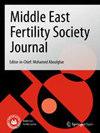评估肥胖和非肥胖多囊卵巢综合征妇女代谢综合征的潜在关联性
IF 1.3
Q4 REPRODUCTIVE BIOLOGY
引用次数: 0
摘要
多囊卵巢综合征是育龄妇女中日益严重的内分泌和生殖疾病,被认为是最主要的健康负担。因此,本研究试图估测肥胖和非肥胖多囊卵巢综合征妇女与代谢综合征的潜在关联。本研究从昌迪加尔(印度北部)PGIMER 的手术室中选取了 250 名多囊卵巢综合征妇女,她们的年龄在 18 至 45 岁之间,居住在昌迪加尔首都地区。采用《鹿特丹标准》(2003 年)对妇女进行多囊卵巢综合征诊断。经美国国家胆固醇教育计划成人治疗小组(NCEP ATP III)评估,发现多囊卵巢综合征妇女的代谢综合征(MS)发病率为 30%(非肥胖者为 4%,肥胖者为 26%)。腰围大于 88 厘米是多囊卵巢综合征妇女最常见的特征(67.2%),其次是高密度脂蛋白小于 50 毫克/分升(56.8%)。多变量逻辑回归分析显示,内脏脂肪指数(VAI)是肥胖(OR = 1.17,P < 0.01)和非肥胖(OR = 1.2,P < 0.01)多囊卵巢综合征女性代谢综合征的重要决定因素。ROC 分析结果进一步确定,内脏脂肪指数是两组多囊卵巢综合征妇女代谢综合征的潜在决定因素。在肥胖的多囊卵巢综合征妇女中,W/H 比值也能准确预测代谢综合征的风险。内脏脂肪指数是评估肥胖和非肥胖两组代谢综合征的重要工具。然而,腰围/臀围比值只能作为肥胖妇女的预测工具。因此,在临床实践中,它可以作为一种重要而廉价的工具,用于早期检测多囊卵巢综合征妇女的代谢综合征。本文章由计算机程序翻译,如有差异,请以英文原文为准。
Evaluation of potential association of metabolic syndrome in obese and non-obese PCOS women
Polycystic ovary syndrome is an escalating endocrinal and reproductive disorder among women of reproductive age and is considered the foremost health burden. Therefore, the present study is an attempt to estimate the potential association of metabolic syndrome in obese and non-obese PCOS women. A total of 250 PCOS women ranging in age from 18 to 45 years and living in the Chandigarh Capital Region were selected from the OPD, PGIMER, Chandigarh, (North India). Rotterdam Criteria (2003) was employed to diagnose polycystic ovary syndrome among women. The prevalence of metabolic syndrome (MS) as assessed by the National Cholesterol Education Program Adult Treatment Panel (NCEP ATP III) was found to be 30% (4% in non-obese and 26% in obese) in PCOS women. Waist circumference > 88 cm is the most prevalent feature in PCOS women (67.2%) followed by HDL < 50 mg/dL (56.8%). The multivariate logistic regression analysis exhibited that visceral adiposity index (VAI) was a significant determinant of metabolic syndrome in obese (OR = 1.17, p < 0.01) and non-obese (OR = 1.2, p < 0.01) PCOS women. Results of ROC analysis further established visceral adiposity index as a potential determinant in metabolic syndrome in both the groups of PCOS women. In obese PCOS women, the W/H ratio also depicted accuracy in predicting metabolic syndrome risk. Visceral adiposity index is a significant tool to assess the metabolic syndrome in both groups, i.e., obese and non-obese. However, the waist/hip ratio can be considered as a predictive tool in obese women only. Thus, it could be used as a significant and inexpensive tool in clinical practices for early detection of metabolic syndrome in PCOS women.
求助全文
通过发布文献求助,成功后即可免费获取论文全文。
去求助
来源期刊

Middle East Fertility Society Journal
REPRODUCTIVE BIOLOGY-
CiteScore
2.80
自引率
0.00%
发文量
32
审稿时长
45 weeks
 求助内容:
求助内容: 应助结果提醒方式:
应助结果提醒方式:


